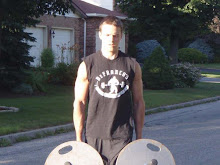
"If you live your life the wrong way, at some point you'll end up in a cardiologist's office. If you live it the right way, at some point you'll end up in an orthopedic surgeon's office."
I guess I've been living my life the right way.
Funny thing is, if I knew then what do now, I wouldn't have had to go through all that pain because I'd have effectively programmed my training to bulletproof my body against possible injury. Then again, if I hadn't gone through all the pain and injuries, I wouldn't have learned what I am about to share with you now.
I've probably done every single pre-habilitation modality known to man. Foam rolling, ART, mobility work, stretching, glute activation, low trap activation, thoracic spine spine mobility, lumbar spine anti-rotation, blah blah blah. You name it, I've programmed it into my training. With great results. I'm not here to tell you not to do these things, they are all extremely valuable, and future blog posts will touch upon each of them and more.
However, within an all-encompassing pre-habilitation program there is one modality that I've seen increase my results (with regards to pain and injury prevention) over and over again. I do this series after each workout, and on off-days as well. It's a series of body weight isometric holds designed to teach proper position, while activating the right muscles (foot intrinsics, psoas, glutes, low traps, serratus anterior) and lengthening the muscles the impede proper activation. I got the original idea from Alex Vasquez of Evolutionary Athletics, before molding it into my own. It really only takes 5-10 minutes, and will really accelerate your injury prevention, movement efficiency and recovery.
I do each hold for 30 seconds, but you can use a shorter or longer time if you want to. Move continuously and smoothly from each hold to the next. Keep a neutral spine throughout and emphasize glute activation, while spreading your toes to grip the ground.
1.) Raise right foot into a psoas activation hold
2.) Pull right leg back out behind you into a single leg RDL position (hold bottom position)
3.) Lower right leg to the ground and assume a lunge position. Be sure to lengthen the right side hip flexor while squeezing both glute muscles.
4.) Pull right foot in line with left and get into a deep squat position
5.) Rise up into a Goodmorning (hold bottom position), while simultaneously holding the top of a prone Y position with upper body.
6.) Keep goodmorning position with lower body while moving into a prone T position with upper body (hold top position of prone T)
7.) Maintain goodmorning, move arms towards hips while rolling shoulders down and back, squeezing shoulder blades together. This is the upper body position of a prone cobra hold.
8.) Move back down into a deep squat position
9.) Pull left leg back behind into a lunge
10.) Rise up onto right leg, pull left leg back into a single leg RDL hold
11.) Pull left leg forward into a psoas activation hold.
12.) Move to the ground and assume the bottom of a pushup position. Use two elevated blocks for extra range of motion. Focus on squeezing shoulder blades together and pulling with the biceps to lengthen the pecs. Avoid anterior tilt of the shoulder - they should be held down and back the entire time.
13.) Roll over into a yoga table pose.
You can also finish by lying on the ground and performing deep breathing into the chest for 5-10 minutes. Try a 5 second in - 5 second out tempo. This dramatically accelerates recovery by shifting your nervous system back into a para-sympathetic dominant state.
When combined with a regular pre-habilitation program of myo-fascial release, stretching, mobility and activation work, this simple routine can greatly improve the way you feel and perform. Try it out after your next workout and let me know what you think.
- T


No comments:
Post a Comment